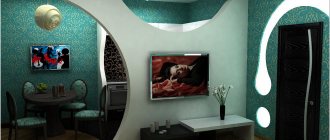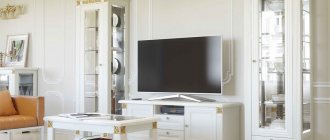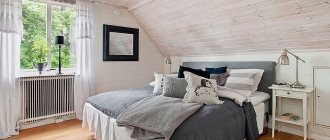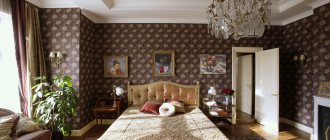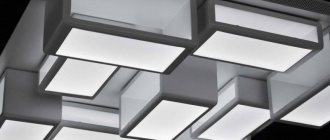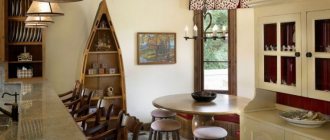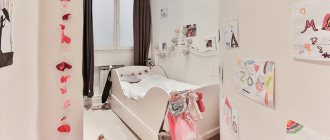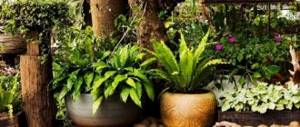Glass structures
Not much time has passed since technological engineers learned how to create large, but at the same time durable glass sheets. But large glass structures have already become firmly established in the design of modern offices, cafes, and apartments. To divide the space, making the most of the natural light in the room, designers are increasingly using frosted glass in the interior.
For example, they make partitions from glass, half transparent, half frosted. This preserves the confidentiality of your work or personal space. At the same time, the maximum amount of light enters it from the windows.
In addition to partitions, doors with transparent inserts, glass floors and even stairs are in fashion today. Of course, such structures can frighten people suffering from acrophobia (fear of heights). But in general, they create a unique design and fill the room with space.
Doors
To emphasize the individuality of the room, you can use decorative glass in the interior: colored, with a pattern, frosted, stained glass, with a sandblasted matte pattern and artistic carvings. Doors made of this material completely change the appearance of the room. At the same time, they can withstand loads and have soundproofing and decorative properties no worse than wooden ones.
Most often, when decorating the interior of premises, doors of this design are used:
#1 wooden with frosted glass, transparent embossed, transparent colored inserts;
#2 double sliding doors made of dimensional transparent sheets in a sandblasted pattern;
#3 sliding doors made of colored or stained glass;
#4 metal structures with stained glass inserts.
Partitions
Transparent partitions are in demand when zoning office space. This idea was first used by American designers. They removed walls from the entire production floor, leaving only supporting elements. We used light from a wall equipped with windows to illuminate the entire office space without interrupting it with dense partitions, but separating it with transparent glass structures. Thus, each employee received a personal workspace, but still felt like part of a single team.
In a small apartment, glass partitions will help maintain a feeling of spaciousness in the rooms. When remodeling an apartment into a studio apartment, the extra walls are demolished, combining the area. If necessary, separate the kitchen or living area using glass in the interior. If you need to protect your personal space - a bedroom or shower room - use a matted or tinted version. Even when using this option, light penetrates the room, maintaining a feeling of freedom and a single area.
Stairs and railings
It’s worth mentioning right away that for the manufacture of stairs they use not ordinary thin glass 3 mm thick, but durable triplex. This is a special three-layer glass with a layer of polymer film.
In addition, the following options are used for steps:
- transparent thick glass with backlight;
- wooden steps with glass railing made of impact-resistant material;
- the spiral staircase is equipped with colored transparent steps and metal railings;
- the metal frame is filled with matte steps and protective panels.
Note: opaque white, black or other glass is perceived as more tangible than transparent glass and looks safer.
Floors
The most exotic way to use glass in the interior is to make flooring out of it. It is best to use such a transparent floor in a multi-storey building, where from the height of the 4th floor you can clearly see what is happening on the first floor. In fact, this idea has already been embodied by designers in bold apartment interior projects in the style of minimalism, hi-tech or fusion. An important condition for transparent floors is that they are made in a common area, for example, between the living room and the hallway or the hall and the living room. Guests will appreciate and remember for a long time how they “floated” above the first floor of the house.
How does glass become frosted?
Initially, glass obtained by melting is transparent. It is made matte using special processing. Used in industry:
- sandblasting method;
- etching;
- use of ceramic paints;
- firing coating.
We decide on the appropriate technology:
- Processing in a sandblasting chamber is an exclusively mechanical method that requires special equipment. The glass is exposed to some kind of loose abrasive, which destroys the top layer. Typically, enterprises use aluminum oxide or fractionated sand for this purpose. This is a rather complicated method, and it is not used at home.
- Etching is a chemical method. The matte effect is achieved by exposing the surface of the material to chemical reagents; hydrofluoric acid is most often used as the main one. Etching can be done at home, but for this it is better to use less aggressive and more accessible substances.
- Matting with ceramic paints is a fairly simple way to achieve an excellent effect. This method has only one drawback - the paints are quite expensive, so the doors can turn out “golden”.
- Applying a fired coating is an effective method; the glass remains frosted for many years. But doors with such a coating are also not cheap.
Glass furniture
In addition to the furniture we are used to - coffee tables with transparent tops, shelves in a display case with dishes - they make unusual glass chairs (colored and transparent), and cabinets. The most unusual example would be a glass designer bed.
Tables
This is one of the sought-after and popular pieces of furniture for a long time. Tables are made coffee, tea, dining, round and square, completely glass or only with a transparent tabletop. They are presentable in appearance, environmentally friendly, and have a strong decorative function. However, they require careful proper care using cleaning products and a soft cloth.
After all, fingerprints, food, and drinks may remain on the glass. If there are small children in the house, you should not choose an unstable table with a central support. While playing, a child may catch it and knock it over. In this case, a solid wooden table on four legs with a transparent top is more suitable.
Shelves and cabinets
Fully glass cabinets with transparent shelves are called showcases. They are used in trade, museums and exhibitions. They can also decorate your home interior. More common are glass shelves in wooden cabinets, or external shelves on the wall. They are used to display glasses, beautiful dishes, figurines, decor or books. For a greater decorative effect, such shelves are illuminated with LED strip.
What and how to clean frosted glass on a door if it is heavily soiled?
The biggest problem with frosted door inserts is not fingerprints, which can be removed very easily if timely measures are taken. It’s worse when adhesive from tape, greasy splashes, paint and other quickly hardening and difficult to wipe off stains get on such a surface. In such cases, it is difficult to find a better option than to clean the frosted glass with a chalk solution or special detergents. As an auxiliary tool, in addition to a soft cloth, it is advisable to get a scraper for washing aquariums, with a blade and a hard rubber strip.
Try to use blades or other sharp objects to clean glass as little as possible, and only in the most extreme cases, since at least small scratches will definitely remain on the surface.
Making a chalk composition is very simple; to do this, place two tablespoons of chalk per liter of cool water and mix thoroughly. The result is a cloudy liquid, which is applied to the surface of the glass using a spray bottle or a regular sponge. After this, you should wait until the solution dries and carefully remove the frozen chalk stains with a scraper, dry paper or napkin. Together with them, both glue and grease can be easily removed. An equally strong alternative to this product is a solution of bleach, which is enough to put only 50 grams per liter of water. The processing method is the same.
When using “Mr. Muscle” or another product similar in principle of action, you should not rush to immediately wash off the applied composition. Before cleaning the frosted glass on the door, generously cover it with the selected liquid, try to foam it with vigorous movements, and then leave it to dry. Then, when the foam has completely hardened, firmly attach the rubber scraper to the glass and, pressing forcefully, move the tool from top to bottom, removing dirty stains along with the dried product. If extraneous traces still remain, everything should be repeated.
In which interiors is glass most often used?
A skilled designer uses frosted glass in the interior as skillfully as regular or colored glass. He uses it as a creative tool that helps realize the most non-trivial ideas. At the same time, it can be used in many interior styles: classic, hi-tech, minimalism, eclecticism and others.
Classic
By filling a solid classic interior with glass structures and details, the designer makes it lighter and more elegant. At the same time, glass tabletops only decorate massive tables with carved legs, and luxurious crystal chandeliers create a festive atmosphere.
Eco style
For this style, glass is just as suitable as stone or wood, as it is a completely environmentally friendly material. In fact, glass contains natural components, it does not emit harmful compounds, can be recycled and goes well with stone or wooden products.
High tech
Glass and chromed metal are fundamental elements of style. Glass is used everywhere in it - as kitchen panels, zoning partitions, furniture, decor, doors.
Minimalism
Colored glass in the interior of an apartment in the minimalist style helps to correctly place accents and divide the area without overloading the space.
Eclecticism
Mixed styles or their elements fill an eclectic interior. Often modern apartments of city residents are made in this style. Here glass is used for furnishing, lighting, dividing and decorating rooms.
When choosing glass for interior design, remember that it has a number of wonderful advantages:
- makes the interior fashionable, interesting, permeated with air and light;
- consists of organic elements and does not emit harmful substances into the air;
- does not lose its properties over time - does not fade, does not deform from moisture or heat;
- has a long service life.
What is glass and how is it obtained?
Before you start cleaning, you need to find out what this material is and what its properties are. This will help you choose the right detergents and cleaning items. In construction stores you can find glass:
- ordinary;
- acrylic.
What are the differences between these 2 types of material:
- Normal - obtained by melting sand. It has an amorphous-crystalline structure. To prevent glass from breaking, various additives are added during its manufacture, as well as dyes.
- Nowadays acrylic glass is becoming increasingly popular. It is made from a polymer obtained artificially. This is an impact-resistant plastic; it withstands mechanical stress much better than ordinary glass, and therefore many people prefer it for the manufacture of doors.
Photo ideas for using glass surfaces in the interior
If you notice an error, a non-working video or link, please select a piece of text and press Ctrl+Enter .
0
Frosting glass at home
You can give the glass a matte effect yourself. There are several simple ways to do this, depending on whether you want to get:
- homogeneous frosted glass;
- glass with a pattern.
Homogeneous frosted glass
The matte effect is produced by a special translucent film with an adhesive base, which can be purchased at a hardware store. You need:
- a piece of film slightly larger than the surface of the glass;
- paper knife or shoe knife;
- metal ruler;
- spray;
- rubber spatula;
- soap or dishwashing liquid;
- water.
This matting method is perhaps the simplest of the existing ones:
- Measure the glass.
- Fill a spray bottle with water.
- If the shape of the glass is simple, draw a figure on the back of the film that exactly matches the shape of the glass.
- Make allowances of 5 cm on each side.
- Cut out the fragment - this is best done with a short knife along a metal ruler.
- Degrease the glass - for example, simply wash it with soapy water, but if necessary, you can also use acetone.
- Peel off the adhesive layer.
- Moisten the film with water from a spray bottle so that it does not stick where it is not needed.
- Start gluing the film to the back of the glass. The allowances should fit onto the profile, and you need to start gluing from the top, smoothing out bubbles and folds with a rubber spatula.
- Trim the seam allowances.
Important! In this simple way, you can make a pattern in which some parts are transparent and others are matte.
Etching
You can also frost glass at home by etching. For this you need:
- special paste (you can make it yourself) or gel;
- cutter;
- soft brush;
- stencil;
- tape (painting);
- polyethylene.
Important! This method is more suitable for applying a matte pattern than for obtaining a uniform surface.
Before you start etching door glass, try the paste on another piece of glass of similar quality. You need to know the etching time, and it depends on both the paste and the depth of the pattern you want to achieve. So, how to make frosted glass:
- Make or buy a stencil.
- Wash and dry the surface of the material before processing.
- The stencil is first applied to copy paper, and then the whole thing is placed on the film (with the ink layer facing it). The entire structure is held together with tape.
- Apply a stencil of self-adhesive film.
- Remove sections of the film from the fragments that are supposed to be left transparent; all parts of the pattern should fit tightly to the glass.
- Cover areas where there is no self-adhesive film with polyethylene - the film is secured with tape. And the lower edge of the polyethylene should be placed in a bowl, where water will drain after the procedure.
- Cover the pattern with a layer of etching paste.
- After the time specified in the instructions or established experimentally has expired, wash off the paste with water using a soft brush.
- Once the etched area has dried, remove the stencil.
Important! If the size of the design is larger than the width of the film, glue the stencil fragments overlapping so that one allowance overlaps the other by 1.5 cm. Cut the stencil with a knife with a short sharp blade.
The most affordable pasta
Paste can be made based on:
- liquid glass;
- hydrofluoric acid.
It is better to use liquid glass:
- Dilute liquid glass with distilled water (available at a pharmacy or auto store).
- Add tooth powder.
- Mix well.
- Apply the paste to the desired areas with a velor roller.
- After etching, rinse off the paste with warm water.
Engraving
A matte pattern can also be applied using engraving. This is a difficult but exciting process. Special equipment is required - abrasive tools.
Important! The procedure is quite long; you will need a couple of hours of free time to practice engraving, every day. You also need a prepared workplace with good lighting, a table covered with a piece of foam rubber. It is better, of course, to equip a workshop, since engraving is a rather dusty business.
It will take a long time to learn engraving, but there are some general rules that will be useful to those who take it up for the first time:
- Draw your design onto the glass using a marker.
- Try going over the lines with a burr (like the one you find at the dentist) with special pads.
- The bur can only be moved in one direction.
What cleaning items are needed?
Frosted glass is, of course, durable, but it can be scratched. Therefore, use only soft cloths and sponges for cleaning:
- suede;
- microfiber;
- flannel.
When cleaning frosted glass, it is very important that it does not become transparent. Therefore, it is better to wash in a certain order:
- Remove stains - greasy, tea and coffee, etc.
- Clean the glass with detergent
- Rinse the glass thoroughly.
- Apply a mixture of chalk and water.
- Wipe the glass with this mixture and let it dry.
- Remove any remaining product with a dry soft cloth.
DIY composition for rubbing frosted glass
- Pour a glass of room temperature water into a bowl.
- Add 4-5 tablespoons of crushed chalk or tooth powder there.
- Mix well.
- Rub the glass.
Important! Periodically, the glass needs to be rubbed with suede.
What do you need to give up?
Both clear and frosted glass are easily scratched. Therefore, the use of abrasive pastes should be avoided. Glass surfaces are contraindicated:
- acids (except for food vinegar, which can be used to remove small stains);
- alkalis;
- petrol.
Important! You should be very careful when using ammonia, which is part of ammonia. It is necessary to monitor the concentration - no more than a few drops per bucket of water.


